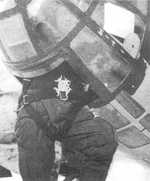Ki-48 Sokei
| Country | Japan |
| Manufacturer | Kawasaki Aircraft Industries |
| Primary Role | Medium Bomber |
Contributor: C. Peter Chen
ww2dbaseKi-48 Sokei light bombers, designated by the Japanese Army as the Type 99 Twin-engined Light Bomber, were originally designed by Takeo Doi of Kawasaki Aircraft Company Limited, who began this project with the Ki-45 heavy fighter design. Meant to be used as a light bomber, they could only each carry 800 kilograms of bombs and only had three machine guns for defense. They first saw service in China starting in late 1940, where they were adequate against Chinese forces which generally lacked modern fighters and anti-aircraft weaponry. When the Pacific War started, they were deployed across all of southeast Asia. In China and Burma, they remained in active service, often used as dive bombers for ground support; in the Pacific islands, however, they were out-classed by American fighters. Near the end of the Pacific War, some Ki-48 aircraft were re-equipped as special attack weapons for suicide missions. During the design's production life, 1,997 examples were built, most of which were of the Ki-48-II variant.
ww2dbaseDuring the war, both the Chinese Nationalist and Communist forces operated captured Ki-48 aircraft; some of these aircraft remained in service until the 1950s. Indonesian forces had one of them, put together from a number of captured inoperable aircraft; it was used against Dutch forces during the Indonesian National Revolution in the late 1940s.
ww2dbaseThe Allies gave the Ki-48 aircraft the codename of Lily.
ww2dbaseSource: Wikipedia
Last Major Revision: Mar 2011
SPECIFICATIONS
Ki-48-II
| Machinery | Two Nakajima Ha.115 radial engines rated at 1,130hp each |
| Armament | 3x7.7mm Type 89 machine guns, 800kg of bombs |
| Crew | 4 |
| Span | 17.45 m |
| Length | 12.75 m |
| Height | 3.80 m |
| Wing Area | 40.00 m² |
| Weight, Empty | 4,550 kg |
| Weight, Loaded | 6,500 kg |
| Weight, Maximum | 6,750 kg |
| Speed, Maximum | 505 km/h |
| Service Ceiling | 10,000 m |
| Range, Normal | 2,400 km |
Photographs
 |  |  |  |
Você gostou deste artigo ou achou este artigo útil? Se sim, considere nos apoiar no Patreon. Qualquer valor já vai ajudar! Obrigado. Por favor, ajude-nos a divulgar o site: Fique atualizado com WW2DB: |
Visitor Submitted Comments
All visitor submitted comments are opinions of those making the submissions and do not reflect views of WW2DB.

- » The Emperor of Japan Planned to Honor WW2-era Japanese POWs in Mongolia (4 Jul 2025)
- » US State Lawmaker John Winter Caught Using Racial Slur "Jap" and Apologized (11 Jun 2025)
- » Köln/Cologne Evacuated After Discovery of WW2 Bombs (4 Jun 2025)
- » Race, Holocaust, and African-American WW2 Histories Removed from the US Naval Academy Library (7 Apr 2025)
- » US Government Plans to Purge WW2 Information (17 Mar 2025)
- » Ver todas as notícias
- » 1,178 biografias
- » 337 eventos
- » 45,089 entradas na linha do tempo
- » 1,245 navios
- » 350 modelos de aeronaves
- » 207 modelos de veículos
- » 376 modelos de armas
- » 123 documentos históricos
- » 261 instalações
- » 470 eventos
- » 28,480 fotos
- » 365 mapas
Captain Henry P. Jim Crowe, Guadalcanal, 13 Jan 1943
Por favor, considere nos apoiar no Patreon. Mesmo R$1 por mês já faz uma grande diferença. Obrigado!
Ou, por favor, nos apoie adquirindo alguns produtos do WW2DB na TeeSpring. Obrigado!
14 Mar 2011 04:09:19 PM
I would love to know if any of these planes are in museums.